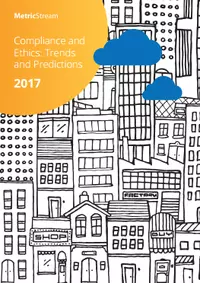

ConnectedGRC
Drive a Connected GRC Program for Improved Agility, Performance, and Resilience
-
BusinessGRC
Power Business Performance and Resilience
Discover ConnectedGRC Solutions for Enterprise and Operational Resilience
Explore What Makes MetricStream the Right Choice for Our Customers
Discover How Our Collaborative Partnerships Drive Innovation and Success
- Want to become a Partner?
Find Everything You Need to Build Your GRC Journey and Thrive on Risk
Learn about our mission, vision, and core values
Compliance and Ethics: Trends and Predictions 2017
Overview
Read this report to discover the key learnings from 2016 ethics and compliance landscape; and what to watch for in 2017.

2016 Trends
Rise in C-level Scandals
In 2016, we saw the re-emergence of C-level corporate scandals that grabbed the headlines. In fact, there were more attention grabbing C-level scandals in 2016 than we’ve seen since the early 2000s - before SOX. These included Wells Fargo’s executives turning a blind eye to the creation of fake accounts, Roger Ailes at FOX resigning due to sexual harassment allegations, Zenefits’ CEO resigning after the company ran into trouble with the law, Mylan’s price-gouging of the life-saving EpiPen, the Volkswagen emissions scandal, the 1MDB fund corruption scandal, the Theranos lab testing scandal, and many more.
Emergence of Anti-corruption Movements
2016 witnessed the emergence of anti-corruption movements as a political force. The government of India demonetized currency notes in an effort to stop tax evasion, inhibit counterfeiting, and reduce systemic public corruption. The impeachment of the president of Brazil started in late 2015 and continued through 2016. China is in the midst of an anti-corruption drive and has set up a G20 research center to boost international anti-corruption cooperation. The MetricStream and Dow Jones global anti-corruption survey found that having anti-corruption programs in place for six to 10-plus years continues to trend upward, nearly reaching 60% of companies. Most of the programs in place have codes of conduct and internal training.
Surge in Heavy Penalties
In the last year, some businesses had to enter into huge settlements for non-compliance. Volkswagen had to pay $15 billion for the diesel-cheating settlement that set the auto industry record. Illegal banking practices cost Wells Fargo $185 million in fines, including a $100 million penalty from the Consumer Financial Protection Bureau.
2017 Predictions
Use of Analytical Tools Will Increase
Despite privacy concerns, companies will increase their use of analytical tools to monitor employees for compliance and anti-corruption. Organizations with mature ethics and compliance programs need an integrated platform to track multiple regulatory changes, tie them to business processes, conduct an impact assessment, gain in-depth compliance risk intelligence, streamline policies and procedures, and track multiple compliance metrics. They should be able to monitor ethics and compliance risks in real time to proactively spot the inconsistencies. There is a huge demand for innovative analytical solutions but the problem is finding the right solution that caters to each organization’s specific ethics and compliance requirements.
Ethics and Compliance Rules Will Be Tightened
While there is an overall trend towards deregulation in the US and other western countries, ethics and compliance rules will be tightened, and companies doing business with government entities will be required to renew their focus on anti-bribery training. The recent tweaking of ISO 37001 (The International Standards Organization’s Anti-bribery Management Systems - Requirements with Guidance for Use), in October 2016 also indicates that globally, anti-bribery and anti-corruption enforcement will be made more stringent.
Enterprises Will More Rigorously Monitor Their Fourth Parties
Extended supply chains and greater reliance on cloud providers mean that what used to be third parties when a process was managed in-house, have become fourth parties. This shift requires that enterprises ensure that their business partners and suppliers are rigorous in monitoring their own third parties. Suppliers, and especially IT and cloud service providers, will be expected to provide strong attestations that their own third-party monitoring programs are effective. In some cases, where risks from business disruption are exceptionally impactful, enterprises will ensure an additional level of direct monitoring of high risk fourth parties.

Subscribe for Latest Updates
Subscribe Now





